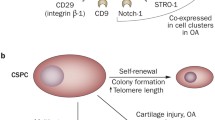Abstract
Introduction
Cartilage endplate (CEP) degeneration is usually accompanied by loss of cellularity, and this loss may be a crucial key factor in initiation and development of degenerative disc disease. The study of cell types in degenerated CEP could help in understanding CEP etiopathogenesis, and may help in devising new treatments, especially if the presence of progenitor cells could be demonstrated. The aim of this study was to determine if progenitor cells existed in degenerated human CEP.
Materials and methods
Cells isolated from CEP were cultured in a three-dimensional agarose suspension to screen for proliferative cell clusters. Cell clusters were then expanded in vitro and the populations were analyzed for colony forming unit, immunophenotype, multilineage induction, and expression of stem cell-related genes.
Results
The presence of progenitor cells in degenerated human CEP is indicated by the results of CFU, immunophenotype, multilineage induction, and expression of stem cell-related genes.
Conclusions
We believe that this is the first study which has conclusively shown the presence of progenitor cells in degenerated CEP. The finding of this study may influence the clinical management of degenerative disc disorder.






Similar content being viewed by others
References
Luoma K, Riihimaki H, Luukkonen R, Raininko R, Viikari-Juntura E, Lamminen A (2000) Low back pain in relation to lumbar disc degeneration. Spine 25:487–492
Holm S, Maroudas A, Urban JP, Selstam G, Nachemson A (1981) Nutrition of the intervertebral disc: solute transport and metabolism. Connect Tissue Res 8:101–119
Magnier C, Boiron O, Wendling-Mansuy S, Chabrand P, Deplano V (2009) Nutrient distribution and metabolism in the intervertebral disc in the unloaded state: a parametric study. J Biomech 42:100–108
Rajasekaran S, Venkatadass K, Naresh BJ, Ganesh K, Shetty AP (2008) Pharmacological enhancement of disc diffusion and differentiation of healthy, ageing and degenerated discs: results from in vivo serial post-contrast MRI studies in 365 human lumbar discs. Eur Spine J 17:626–643
Boyd LM, Carter AJ (2006) Injectable biomaterials and vertebral endplate treatment for repair and regeneration of the intervertebral disc. Eur Spine J 15(Suppl 3):S414–S421
Holm S, Holm AK, Ekstrom L, Karladani A, Hansson T (2004) Experimental disc degeneration due to endplate injury. J Spinal Disord Tech 17:64–71
Peng B, Hou S, Shi Q, Jia L (2001) The relationship between cartilage end-plate calcification and disc degeneration: an experimental study. Chin Med J (Engl) 114:308–312
Roberts S, Urban JP, Evans H, Eisenstein SM (1996) Transport properties of the human cartilage endplate in relation to its composition and calcification. Spine 21:415–420
Antoniou J, Goudsouzian NM, Heathfield TF, Winterbottom N et al (1996) The human lumbar endplate. Evidence of changes in biosynthesis and denaturation of the extracellular matrix with growth, maturation, aging, and degeneration. Spine 21:1153–1161
Ariga K, Miyamoto S, Nakase T, Okuda S et al (2001) The relationship between apoptosis of endplate chondrocytes and aging and degeneration of the intervertebral disc. Spine 26:2414–2420
Liebscher T, Haefeli M, Wuertz K, Nerlich AG, Boos N (2011) Age-related variation in cell density of human lumbar intervertebral disc. Spine 36:153–159
Moore RJ (2006) The vertebral endplate: disc degeneration, disc regeneration. Eur Spine J 15(Suppl 3):S333–S337
Hattori S, Oxford C, Reddi AH (2007) Identification of superficial zone articular chondrocyte stem/progenitor cells. Biochem Biophys Res Commun 358:99–103
Fickert S, Fiedler J, Brenner RE (2004) Identification of subpopulations with characteristics of mesenchymal progenitor cells from human osteoarthritic cartilage using triple staining for cell surface markers. Arthritis Res Ther 6:R422–R432
Alsalameh S, Amin R, Gemba T, Lotz M (2004) Identification of mesenchymal progenitor cells in normal and osteoarthritic human articular cartilage. Arthritis Rheum 50:1522–1532
Richardson SM, Hoyland JA, Mobasheri R, Csaki C, Shakibaei M, Mobasheri A (2010) Mesenchymal stem cells in regenerative medicine: opportunities and challenges for articular cartilage and intervertebral disc tissue engineering. J Cell Physiol 222:23–32
Risbud MV, Guttapalli A, Tsai TT, Lee JY et al (2007) Evidence for skeletal progenitor cells in the degenerate human intervertebral disc. Spine 32:2537–2544
Blanco JF, Graciani IF, Sanchez-Guijo FM, Muntion S et al (2010) Isolation and characterization of mesenchymal stromal cells from human degenerated nucleus pulposus: comparison with bone marrow mesenchymal stromal cells from the same subjects. Spine 35:2259–2265
Benya PD, Shaffer JD (1982) Dedifferentiated chondrocytes reexpress the differentiated collagen phenotype when cultured in agarose gels. Cell 30:215–224
Thornemo M, Tallheden T, Sjogren JE, Larsson A et al (2005) Clonal populations of chondrocytes with progenitor properties identified within human articular cartilage. Cells Tissues Organs 180:141–150
Modic MT, Steinberg PM, Ross JS, Masaryk TJ, Carter JR (1988) Degenerative disk disease: assessment of changes in vertebral body marrow with MR imaging. Radiology 166:193–199
Sekiya I, Larson BL, Smith JR, Pochampally R, Cui JG, Prockop DJ (2002) Expansion of human adult stem cells from bone marrow stroma: conditions that maximize the yields of early progenitors and evaluate their quality. Stem Cells 20:530–541
Kolf CM, Cho E, Tuan RS (2007) Mesenchymal stromal cells. Biology of adult mesenchymal stem cells: regulation of niche, self-renewal and differentiation. Arthritis Res Ther 9:204–214
Dominici M, Le BK, Mueller I, Slaper-Cortenbach I et al (2006) Minimal criteria for defining multipotent mesenchymal stromal cells. The International Society for Cellular Therapy position statement. Cytotherapy 8:315–317
Dennis JE, Carbillet JP, Caplan AI, Charbord P (2002) The STRO-1+ marrow cell population is multipotential. Cells Tissues Organs 170:73–82
Carlin R, Davis D, Weiss M, Schultz B, Troyer D (2006) Expression of early transcription factors Oct-4, Sox-2 and Nanog by porcine umbilical cord (PUC) matrix cells. Reprod Biol Endocrinol 4:8–21
Acknowledgments
This work was supported by the National Natural Science Foundation of China (No. 81071498 and No. 81071496).
Conflict of interest
None.
Author information
Authors and Affiliations
Corresponding authors
Additional information
B. Huang and L.-T. Liu are co-first authors.
B. Huang and L.-T. Liu contributed equally to this work.
Rights and permissions
About this article
Cite this article
Huang, B., Liu, LT., Li, CQ. et al. Study to determine the presence of progenitor cells in the degenerated human cartilage endplates. Eur Spine J 21, 613–622 (2012). https://doi.org/10.1007/s00586-011-2039-4
Received:
Revised:
Accepted:
Published:
Issue Date:
DOI: https://doi.org/10.1007/s00586-011-2039-4




